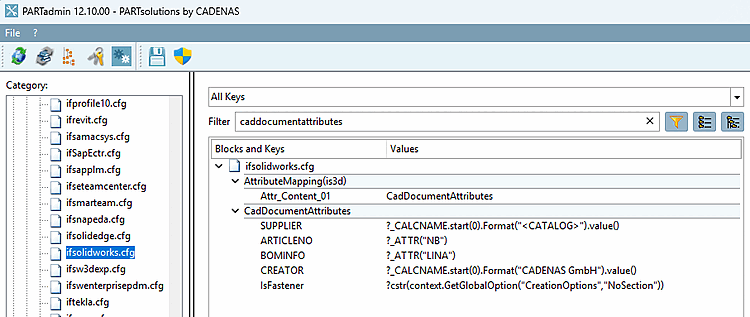Under "CadDocumentAttributes" you can find information that is transferred to the respective CAD program when exporting from PARTsolutions. Some of these values are transferred directly, others are dynamically queried via function calls, such as the catalog manufacturer (SUPPLIER) [first line in the following figure].
[CadDocumentAttributes]
Valid syntax for attributes is:
Map a table variable into the given attribute
CadAttrName=?_ATTR("NB")Map a VB expression into the given attribute, valid are also ?"3.1415926" ORELSE ?"This is a text"
CadAttrName=?AnyVBExpr
Attribute is mapped as value ORELSE as string
in this way, the type of attribute is set
CadAttrName.Type=val|str
The following is partly CAD-dependent information
CadAttrName.Custom=Any Custom Data
DN=42 DN.CUSTOM=category.partsolutions
Multiple values can be entered separated by commas.
DN=42 DN.CUSTOM=type.number,category.partsolutions
Marking an attribute as a mandatory attribute
Adding this parameter to mapped attributes will cause them to be mapped during the initial model creation process (before geometry), as required by NX 2312 (or later).
Not setting this flag has no effect in earlier NX versions, but starting with NX2312 the model export will fail with error message "The attribute not found" if not all mandatory attributes in the configuration file
ifugnx.cfgare marked as such.DN=42 DN.CUSTOM=flag.mandatory
The Section "CopyFrom" also accepts complete statements .. the %ATTRNAME% is reduced by the current var
CopyFrom..=_FORMAT_0("MYPREFIX_HERE<ATTR-(%ATTRNAME%)>-MYPOST_HERE").value()
In addition, the "CopyFrom" may contain the following filter/flags:
Sometimes one and the same variable can have different values, depending on the context of the part. This means that multiple entries are also possible.
What happens if several assignments apply?
The first applicable entry (we think of the return value of functions) is taken. So if you enter a default value first without any checks, it will always be taken. See the last line in the following illustration. The following assignments of these variables are never executed by the program.
![[Note]](https://webapi.partcommunity.com/service/help/latest/pages/jp/3dfindit/doc/images/note.png) | Note |
|---|---|
Always list from the specific assignment of the attribute to the more general one up to the assignment of the default value! | |



